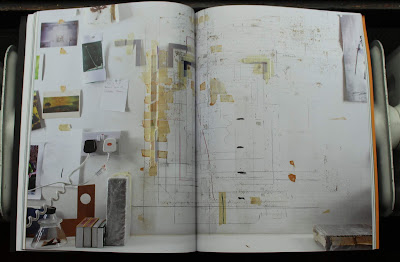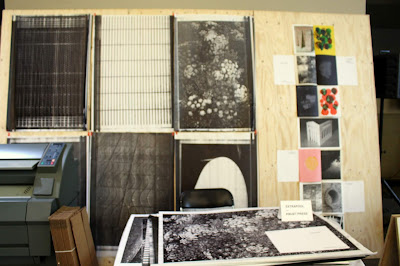STAECK, Klaus.
Pornografie.
Germany: Anabas-Verlag Gunter Kampf, 1971. First Edition. Quarto. Full-page black and white images of destruction, police brutality, and images from Vietnam. One of the great antiwar and anti-violence artists' books of the era. (Parr / Badger, v2, 150-151).
The only work he could get was cleaning the morbidly obese. It was hard work but it was better than nothing. All day he lifted folds, swabbed sweaty crevices and lanced various pustules. The people were generally nice and thankful. One day as he worked on a particularly tough leg boil a woman farted right in his face. “Lady, why do have to make my job gross?”
Everything is relative. Anything can be made glorious or gross depending on your perspective. Klaus Staeck zooms right in in his 1971 book PORNOGRAFIE shortening the viewers depth of field. As a lawyer who passed the German Bar in 1969 Herr Staek was well acquainted with the distorting power of the magnifying lens. He uses this power with blunt force in an attempt to revitalize images and objects which in many cases, even though they contain obvious brutality, have become mundane.
‘GEWELD IS SEXY, LIJDEN IS PORNO.’
08 Mar 2016 - Merel van der Velde
In het journaal wordt je ermee overspoeld: beelden van het lijden van de mens. Overstromingen, bomaanslagen, treinontsporingen, vluchtelingen, aardbevingen en wijdverspreide armoede: we kijken er allemaal dagelijks naar. Veel nieuws is slecht nieuws, niets is te dramatisch, maar waarom zoeken we deze horror dagelijks op? Welke behoefte bevredigen we met het zien van deze beelden? We willen mee kunnen praten en worden gedreven door angst; the fear of missing out. Een andere reden is dat we trots zijn op onze compassie voor de mensheid (Zie mij vol empathie de knopjes van mijn afstandsbediening bespelen). Of geeft het zien van alle misère ons een tevreden gevoel omdat onze dagelijkse banale ‘problemen’ daardoor wel mee lijken te vallen? Een confronterend argument, maar daardoor niet minder waar, is sensatiedrift. Het is spannend om bloed en drama voorbij te zien flitsen, misschien zelfs opwindend.
De Duitse kunstenaar Klaus Staeck toont met het boek Pornografie onze oerbehoefte aan ramptoerisme. In de jaren ’60 en ’70 is Staeck actief op het gebied van provocerende fotomontages; politieke satire. Staeck is populair bij links en komt regelmatig in juridische strijd met conservatieve politici. Met de publicatie uit 1971, waarin hij talloze beelden uit kranten en tijdschriften samenbrengt, lukt het ook in 2016 om de lezer te shockeren. Je ziet korrelige detailfoto’s in zwart-wit van de lijdende, de strijdende, de stervende en de dode. Gezichten met ogen vol blinde woede, wanhoop en pijn kijken je aan vanuit de bladzijden die tussen je vingers door glippen. Paginanummers ontbreken. Je wilt kijken, maar ook wegkijken: het is gelijktijdig aantrekkelijk en afstotend, als een te grafische pornofilm. Deze publicatie toont de intimiteit van rivalen in brute omhelzing, opstandelingen vol passie en polsen door handboeien geketend. Je kijkt recht in een opening bij de lies, wat je ziet is een vlezige wond die achterblijft na het afhakken van een ledemaat. Enkele tekstfragmenten onderbreken de overvloed aan beelden, maar zetten de trend van gruwel voort.

Een tekstuele onderbreking omschrijft martelingen
De tekst vertelt over bloedende genitaliën en ambtenaren die met plezier een stok besmeurd met mosterd in een willekeurige anus duwen. Soms zitten er glassplinters in het stuk hout. Een elfjarig meisje wordt gemarteld met elektroshocks en ontmaagd, verkracht. Deze monsterlijke daden worden verhaald in een kalme opsomming. De huiveringwekkende realisatie dat deze gruwelijkheden dagelijkse werkelijkheid zijn vermenigvuldigt de kracht van de woorden.
De politie komt steeds terug in beeld als de boosdoener, als degene die foltert en pijnigt. Staeck toont de Pigs en hun machtsmisbruik. De agenten op de foto’s lijken ervan te genieten om hun slachtoffers te martelen. Verderop heft een blij kind met soldatenhelm zijn arm, klaar om te slaan, de glimlach maakt het tafereel angstaanjagend. Het jochie kent geen goed of kwaad, maar kopieert het gedrag van de ‘grote mensen’.
Een kleine jongen speelt soldaatje
Als we de reclamespotjes van de afgelopen decennia mogen geloven worden we pas daadwerkelijk gelukkig als we de perfecte auto, crèmespoeling of groentemix in huis hebben. Huppelende, blonde vrouwen glimlachen hun witte tanden bloot wanneer ze de juiste messenset in huis hebben gehaald. Staeck beeld een serie verdachte huishoudelijke voorwerpen af: de lezer kan na voorgaande gruwelen niets meer als onschuldig beschouwen. En schijn blijkt niet te bedriegen: de objecten krijgen de functie van wapens. Door simpelweg te bladeren lijk je de fysieke pijn in je eigen lichaam te voelen: een vishaak door je lip, een kaasmes in je arm en een citruspers die je oogkas doorboort. Alles is een close-up, genomen met een akelig kleine afstand. Huis- tuin- en keukenvoorwerpen kunnen onnoemelijke schade aanrichten, terwijl geweren en kogels als onschadelijk speelgoed aan de man worden gebracht. Reclameposters tonen hoe de kapitalistische vrije markt dankbaar gebruik maakt van een behoefte aan agressie. Strijden heeft plaats gemaakt voor kopen. Het bekende beeld van de protesterende vuist wordt nu gebruikt om een mannenluchtje aan te prijzen en ontblootte vrouwenbenen promoten een geweer. Geweld is sexy, lijden is porno.

Keukengerei
Moordwapen
Vurig protest, teruggebracht tot handelsmerk
Verleidelijke wapens
In een wereld vol geweld, die we dagelijks via alle mogelijke media op ons netvlies krijgen, kun je je hopeloos verloren voelen. Wanneer je snel door dit boek bladert verschilt het amper van het zappen langs tweehonderd televisie kanalen of het scrollen door je tijdlijn op Facebook. Het bekijken van Staecks Pornografie in 2016 maakt pijnlijk duidelijk dat het enorme aantal (gruwelijke) beelden dat wij dagelijks ongevraagd te zien krijgen, ons steeds minder doet realiseren waar we eigenlijk naar kijken. Wie het voorbijflitsen stillegt en in dit boek wat langer naar de beelden kijkt, één voor één, ziet dat de lijdende gezichten bij echte mensen horen.
Voor wie de confrontatie te groot is volgt een simpel advies: sluit het boek. Je vergeet het leed waarschijnlijk binnen enkele uren, minuten, wellicht luttele seconden. Echter zul je eraan herinnerd worden bij het zien van een opbeurende reclameposter, het deprimerende journaal of een sappige pornofilm. Voor onze hedendaagse, gewelddadige beeldcultuur kunnen (en willen) we ons niet afsluiten.
 Come to Java 1922-23 by Official Tourist Bureau Weltevreden Java see for a slideshow on Flickr ... photography by Kurkdjian Surabaya
Come to Java 1922-23 by Official Tourist Bureau Weltevreden Java see for a slideshow on Flickr ... photography by Kurkdjian Surabaya
 Onnes (or Ohannes) Kurkdjian, born in 1851, was an Armenian photographer who was based in Yerevan for part of the 19th century. Kurkdjian later emigrated from Armenia. He lived in Singapore for a short period - spending just over two months there in 1885 and working for another Armenian photographer. He then moved to the port town of Surabaya on the island of Java, Dutch East Indies (now Indonesia), where he continued his profession as a photographer. He eventually owned a photographic "atelier" studio in Surabaya, with more than thirty photographers and darkroom assistants, producing photographs that are now highly prized for their topographical and anthropological content. The studio's photographs were also reproduced on picture postcards. He died in Surabaya in 1903 (some accounts say 1901, or 1904). After his death the company was taken over by the pharmaceutical import company "Helmig". Read more ...
Onnes (or Ohannes) Kurkdjian, born in 1851, was an Armenian photographer who was based in Yerevan for part of the 19th century. Kurkdjian later emigrated from Armenia. He lived in Singapore for a short period - spending just over two months there in 1885 and working for another Armenian photographer. He then moved to the port town of Surabaya on the island of Java, Dutch East Indies (now Indonesia), where he continued his profession as a photographer. He eventually owned a photographic "atelier" studio in Surabaya, with more than thirty photographers and darkroom assistants, producing photographs that are now highly prized for their topographical and anthropological content. The studio's photographs were also reproduced on picture postcards. He died in Surabaya in 1903 (some accounts say 1901, or 1904). After his death the company was taken over by the pharmaceutical import company "Helmig". Read more ...








































































